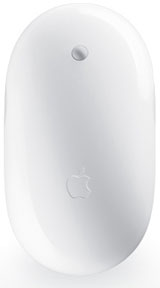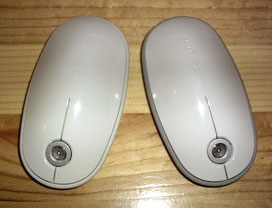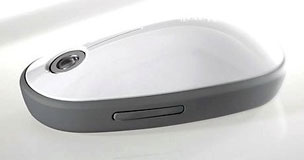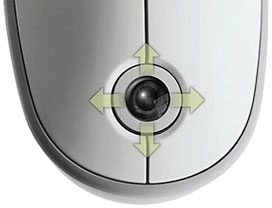Targus for Mac Wireless Mouse: 
Targus for Mac Bluetooth Laser Mouse: 
Apple's new wireless Magic Mouse, introduced last
week, may well turn out to be the best computer mouse Apple has ever
offered. Unfortunately, the bar isn't set very high, especially in the
USB era.
Apple's Hockey Puck
 The original
"hockey puck" Apple USB mouse that shipped with the original iMacs and Power Macs
of the era was something of a self parody. Almost everyone hated it. I
know I found it annoying and uncomfortable to use, although my daughter
liked it and still says it's one of her favorite mice.
The original
"hockey puck" Apple USB mouse that shipped with the original iMacs and Power Macs
of the era was something of a self parody. Almost everyone hated it. I
know I found it annoying and uncomfortable to use, although my daughter
liked it and still says it's one of her favorite mice.
Actually, it's turned out to be one of my favorite mice too, but for
an unconventional reason. I've discovered that with the ball removed
and the hole taped over (to prevent dust from collecting inside), the
Apple hockey puck mouse makes an excellent foot mouse for clicking.
I have chronic neuritis and find most clicking tends to aggravate
the nerves in my arms and hands, causing pain and motor issues, so I do
what I can to minimize that sort of stress. Clicking with my foot has
proved an excellent workaround. The hockey puck mouse's rounded
contours make it comfortable to operate (clicking only - I haven't even
attempted to master tracking with my foot) in a sock or barefoot.
They seem to stand up amazingly well under this sort of hard use
that they were never designed for, and the shortest time I've had one
in this service before mechanical failure of the switch was around one
year. The latest one has lasted more than two years and is still going
strong. I'm in no danger from running short of them, since a friend in
the computer repair business handed off a whole bagful of them, all
blueberry and all in excellent condition, as a gift.
Apple's Later USB Mice
I digress. Anyway, the first "serious" Apple USB mouse, which
had a much more conventional shape, made the entire upper housing the
"button". It was something of an improvement, but I still didn't like
the one that shipped with my G4 Cube very much and quickly
substituted a third-party two-button mouse.
I haven't been very happy getting along with one button for a long
time - actually, almost since I first experimented with using a
two-button mouse back in the mid-90s. Aside from it's only having one
oversized "button", I also didn't like the relatively stiff action of
Apple's mouse, although its shape was reasonably comfortable. MacMice made several much nicer-to-use rodents
with essentially the same housing shape, but with two buttons and a
scroll wheel.
 However, as uninspiring as the second USB Apple
mouse was, it was better than iteration three: the late, unlamented
Apple Mighty Mouse, which I consider one of the worst computer mice
ever made. Instead of a decent scroll wheel, Apple insisted on using a
woefully undersized and near-useless trackball, adding insult to injury
by making the trackball mechanism impossible to take apart and clean
when it inevitably got gummed-up with grime.
However, as uninspiring as the second USB Apple
mouse was, it was better than iteration three: the late, unlamented
Apple Mighty Mouse, which I consider one of the worst computer mice
ever made. Instead of a decent scroll wheel, Apple insisted on using a
woefully undersized and near-useless trackball, adding insult to injury
by making the trackball mechanism impossible to take apart and clean
when it inevitably got gummed-up with grime.
Apple's Magic Mouse
Now we have Apple's third mouse design since the round USB mouse,
dubbed Magic Mouse, and this time instead of a trackball, it
incorporates a mini trackpad supporting Apple's Multi-Touch™
technology that was originally developed for the iPhone, iPod touch,
and Apple notebook trackpads. Multitouch allows Magic Mouse users to
navigate using finger gestures.
Instead of mechanical buttons, scroll wheels, or trackballs, the
entire top of the Magic Mouse is a seamless multitouch surface on top
of a touch-sensitive enclosure, which allows it to be a virtual single-
or multibutton mouse with gesture support. Using gestures, users can
scroll through long documents, pan across large images or swipe to move
forward or backward through a collection of web pages or photos. Magic
Mouse works for left- or right-handed users, and multibutton or gesture
commands can be configured from within System Preferences.
The Magic Mouse uses a laser tracking sensor that works effectively
on a wider variety of surfaces than traditional optical tracking
systems, and it communicates with the computer via the Bluetooth
wireless interface. The wireless Magic Mouse is powered by two AA
batteries, and to extend battery performance, it includes an advanced
power management system that works with Mac OS X to automatically
switch the mouse to low power mode during periods of inactivity.
This all sounds very promising. I haven't actually gotten my hands
on one yet, being out here in the boonies (150 miles from the nearest
Apple authorized reseller). I may actually end up liking the Magic
Mouse, which would make it the first Apple mouse that appealed to me
since the ADB era - other
than my esoteric usage of the hockey puck version.
Targus Touch Scroll
However, I'm not completely inexperienced using mice that operate
via finger gestures rather than mechanical solutions like scroll
wheels. For more than a year now, Targus has been offering two mice in
its
"For Mac" suite of computer peripherals, both of which incorporate
Targus' Touch Scroll four-way wheel-less optical scrolling and quick
scroll technology.
 Touch Scroll is not quite as sophisticated as Apple's
Multi-Touch, and the Targus Touch Scroll mice still have conventional
buttons for clicking, but Touch Scroll works on an analogically similar
principle. I find it quite pleasant and effective to use, although I
still think I prefer the nicely weighted scroll wheel in my
Logitech V550 mouse, which also supports horizontal scrolling by
nudging the scroll wheel to the left or right.
Touch Scroll is not quite as sophisticated as Apple's
Multi-Touch, and the Targus Touch Scroll mice still have conventional
buttons for clicking, but Touch Scroll works on an analogically similar
principle. I find it quite pleasant and effective to use, although I
still think I prefer the nicely weighted scroll wheel in my
Logitech V550 mouse, which also supports horizontal scrolling by
nudging the scroll wheel to the left or right.
Nevertheless, Targus' Touch Scroll technology is very slick and gets
quite addictive.
The Wireless Mouse and Bluetooth Laser Mouse are identical in size
and shape; they share a large proportion of their engineering, with the
main distinctions being that one uses conventional optical tracking
technology and while the other uses laser tracking and connects via
Bluetooth, obviating the need for a receiver dongle on Macs equipped
with Bluetooth.
As with most USB RF wireless receivers these days,
the Targus Wireless Mouse 's unit is low profile, so in most instances
it will be possible to leave it plugged in a laptop USB port when the
computer is carried or stored in a computer case or sleeve. If that's
not convenient, there's a handy slot inside the mouse for storing or
transporting the RF receiver securely when it's unplugged from the
computer.
I hasten to add that while the Wireless Mouse for Mac's
low-profile receiver is a specifically laptop-friendly feature, these
two mice are not undersized "notebook mice". Indeed, they are perhaps a
bit larger than average by current standards (exterior dimensions:
2.51" x 1.45" x 4.64"). That suits me just fine, as I like largish mice
for use with either laptop or desktop computers - and your hands don't
get any smaller when you travel.
 Styling-wise, the two mice are very similar, the main
difference being that the Wireless Mouse for Mac's housing is entirely
the glossy "Lunar Gray" plastic, a Targus for Mac signature, and the
Bluetooth Laser Mouse for Mac is two-tone with a darker gray bottom
case housing. Personally, I prefer the look of the all Lunar Gray unit,
but that's just my subjective preference.
Styling-wise, the two mice are very similar, the main
difference being that the Wireless Mouse for Mac's housing is entirely
the glossy "Lunar Gray" plastic, a Targus for Mac signature, and the
Bluetooth Laser Mouse for Mac is two-tone with a darker gray bottom
case housing. Personally, I prefer the look of the all Lunar Gray unit,
but that's just my subjective preference.
Being
cordless mice, these units are both powered by onboard batteries,
happily standard AA cells all-round (the same kind used in Apple's
Magic Mouse). AA's are cheap and easy to find almost anywhere. AA cells
are fairly heavy, but Targus has done a good engineering job of making
these mice smooth, well-balanced, slick trackers. Estimated battery
life is up to six months, and the Touch Scroll optical scanner will
blink when less than one hour of battery life remains. (Editor's note:
We have contacted Targus regarding compatibility with rechargeable
batteries and will update this column with that information once we
receive our answer. dk)
Both Targus mice have a manual power button on their undersides so
you can positively power them down when idle.
Hands On
 As for using the four-way optical Touch Scroll
optical sensor technology that replaces the usual scroll ball or scroll
wheel, I found it quite intuitive with almost no learning curve
climbing required. Cursor movement is activated by moving your
fingertip directionally across the optical sensor, which is a
natural-feeling way of manipulation. I did have to dial down the
scrolling speed in the OS X preferences from where I had it set
for my usual, scrollwheel equipped mouse. I found that scrolling in
small increments for precision tasks isn't quite as easy to modulate as
it is with a really good, sensitive, weighted scroll wheel, but it's
better than some scroll wheels I've used. Especially convenient is the
quick scrolling function that facilitates rapid scrolling up and down
through lengthy documents with a quick swipe (gesture) of your
fingertip. (For more, see Moore's 4-way Touch Scroll in Targus Mice
More than Just a Cool Gimmick.)
As for using the four-way optical Touch Scroll
optical sensor technology that replaces the usual scroll ball or scroll
wheel, I found it quite intuitive with almost no learning curve
climbing required. Cursor movement is activated by moving your
fingertip directionally across the optical sensor, which is a
natural-feeling way of manipulation. I did have to dial down the
scrolling speed in the OS X preferences from where I had it set
for my usual, scrollwheel equipped mouse. I found that scrolling in
small increments for precision tasks isn't quite as easy to modulate as
it is with a really good, sensitive, weighted scroll wheel, but it's
better than some scroll wheels I've used. Especially convenient is the
quick scrolling function that facilitates rapid scrolling up and down
through lengthy documents with a quick swipe (gesture) of your
fingertip. (For more, see Moore's 4-way Touch Scroll in Targus Mice
More than Just a Cool Gimmick.)
With 1200 dpi tracking resolution optical and laser sensors
respectively, both of these Targus mice are fast and accurate for
precision pointing tasks (with a qualification on that for the
Bluetooth unit that I'll get to in greater detail in a moment). Both
mice have a wireless range of up to 33 feet, which might be helpful for
making presentations with your laptop, although I would recommend
checking out the Targus for Mac Bluetooth Presenter (which also
incorporates the optical Touch Scroll technology) if you do a lot of
that.
One big distinction between these Targus mice and the Apple Magic
Mouse is that these units have buttons as aforementioned - the front
part of the top housing is split in order to let it flex under finger
pressure to do double duty actuating the left/right click functions. I
found the Targus mice have a very pleasant tactile feel for clicking -
smooth and positive with just the right amount of effort required - not
too stiff and not too light on the trigger. Full marks in that
department, and I think I prefer having mechanical buttons to the
gestures that will be required for virtual clicking with the Magic
Mouse.
Basic click and scroll functions work just
fine with OS X's default mouse drivers, but a download and install of
Targus' proprietary driver software, which installs a System Preference
panel, is required in order to use the programmable third and forth
click buttons, which can be configured for individualized one-click
access to favorite functions, programs or toggling AppleScripts. These
buttons are located on the left side of the lower housing in a
low-profile rocker switch configuration that is out of your way when
you're not using them, but is fairly conveniently accessible for your
thumb if you're right-handed. However, allowing them to protrude just a
bit more would have made them easier to actuate, due to the inward
taper of the lower housing.
Bluetooth's Shortcomings
I personally have a preference for RF connected wireless mice, and I
am not much of a Bluetooth fan, even though I appreciate its several
advantages: no RF receiver dongle to plug in, using up a precious USB
port (always at a premium on Apple laptops), and potentially getting
lost or misplaced.
However, I find Bluetooth's shortcomings, such as the necessity of
Bluetooth configuration (device seeking and pairing) a pain. OS X's
Bluetooth Setup Assistant does a good job of making this relatively
straightforward, but it's still time-consuming and an unwelcome extra
hassle. There is also the standard Bluetooth wake-up lag while
connection is restored after the computer and/or mouse have been
asleep.
The heretofore most egregious thing about Bluetooth, cursor latency
- that microsecond of lag between moving the mouse and cursor response
- has been much improved in recent Bluetooth mice, including these from
Targus, but the RF version still has the edge in instant "right there,
right now" responsiveness. Happily with the For Mac series, Targus
gives you the option of essentially the same cool feature set, save for
Bluetooth connectivity and a laser sensor, in the less-expensive
Wireless Mouse for Mac.
Summing Up
Both Targus mice require Mac OS
X 10.4 "Tiger" or better, and of course the Bluetooth model demands
a Bluetooth-equipped Mac. Magic Mouse requires Mac OS X 10.5.8 or later, so
OS X 10.4 holdouts - and folks who use even older versions of the
Mac OS - are out of luck with Apple's newest mouse.
Tiger users can use the Targus mice, which are really nice products
with a very high standard of finish, and the Touch Scroll technology is
genuinely innovative and not a gimmick. It remains to be seen how
gimmicky users find the Multi-Touch Magic Mouse. I turned out liking
the Multi-Touch, å trackpad in my Unibody MacBook more than I
thought I would.
I do, however, like the presence and feel of Targus mice's main
click buttons, the smoothness with which these mice glide across my
mouse pad, and the Touch Scroll feature works well. They appear to be
well made and are backed by a one-year Targus limited warranty.
Ratings
- Targus for Mac Wireless Mouse: 4 out of 4
- Targus for Mac Bluetooth Laser Mouse: 3 out of 4
A rating for the Magic Mouse will have to wait.
The Targus Bluetooth Laser Mouse for Mac sells for $69.99, which is
99¢ more than Apple wants for the Magic Mouse. However, the Targus
Wireless Mouse for Mac sells for an easier-to-swallow $49.99.
Purchase Links

 The
The  However, as uninspiring as the second USB Apple
mouse was, it was better than iteration three: the late, unlamented
Apple Mighty Mouse, which I consider one of the worst computer mice
ever made. Instead of a decent scroll wheel, Apple insisted on using a
woefully undersized and near-useless trackball, adding insult to injury
by making the trackball mechanism impossible to take apart and clean
when it inevitably got gummed-up with grime.
However, as uninspiring as the second USB Apple
mouse was, it was better than iteration three: the late, unlamented
Apple Mighty Mouse, which I consider one of the worst computer mice
ever made. Instead of a decent scroll wheel, Apple insisted on using a
woefully undersized and near-useless trackball, adding insult to injury
by making the trackball mechanism impossible to take apart and clean
when it inevitably got gummed-up with grime. Touch Scroll is not quite as sophisticated as Apple's
Multi-Touch, and the Targus Touch Scroll mice still have conventional
buttons for clicking, but Touch Scroll works on an analogically similar
principle. I find it quite pleasant and effective to use, although I
still think I prefer the nicely weighted scroll wheel in my
Touch Scroll is not quite as sophisticated as Apple's
Multi-Touch, and the Targus Touch Scroll mice still have conventional
buttons for clicking, but Touch Scroll works on an analogically similar
principle. I find it quite pleasant and effective to use, although I
still think I prefer the nicely weighted scroll wheel in my  Styling-wise, the two mice are very similar, the main
difference being that the Wireless Mouse for Mac's housing is entirely
the glossy "Lunar Gray" plastic, a Targus for Mac signature, and the
Bluetooth Laser Mouse for Mac is two-tone with a darker gray bottom
case housing. Personally, I prefer the look of the all Lunar Gray unit,
but that's just my subjective preference.
Styling-wise, the two mice are very similar, the main
difference being that the Wireless Mouse for Mac's housing is entirely
the glossy "Lunar Gray" plastic, a Targus for Mac signature, and the
Bluetooth Laser Mouse for Mac is two-tone with a darker gray bottom
case housing. Personally, I prefer the look of the all Lunar Gray unit,
but that's just my subjective preference. As for using the four-way optical Touch Scroll
optical sensor technology that replaces the usual scroll ball or scroll
wheel, I found it quite intuitive with almost no learning curve
climbing required. Cursor movement is activated by moving your
fingertip directionally across the optical sensor, which is a
natural-feeling way of manipulation. I did have to dial down the
scrolling speed in the OS X preferences from where I had it set
for my usual, scrollwheel equipped mouse. I found that scrolling in
small increments for precision tasks isn't quite as easy to modulate as
it is with a really good, sensitive, weighted scroll wheel, but it's
better than some scroll wheels I've used. Especially convenient is the
quick scrolling function that facilitates rapid scrolling up and down
through lengthy documents with a quick swipe (gesture) of your
fingertip. (For more, see Moore's
As for using the four-way optical Touch Scroll
optical sensor technology that replaces the usual scroll ball or scroll
wheel, I found it quite intuitive with almost no learning curve
climbing required. Cursor movement is activated by moving your
fingertip directionally across the optical sensor, which is a
natural-feeling way of manipulation. I did have to dial down the
scrolling speed in the OS X preferences from where I had it set
for my usual, scrollwheel equipped mouse. I found that scrolling in
small increments for precision tasks isn't quite as easy to modulate as
it is with a really good, sensitive, weighted scroll wheel, but it's
better than some scroll wheels I've used. Especially convenient is the
quick scrolling function that facilitates rapid scrolling up and down
through lengthy documents with a quick swipe (gesture) of your
fingertip. (For more, see Moore's 
